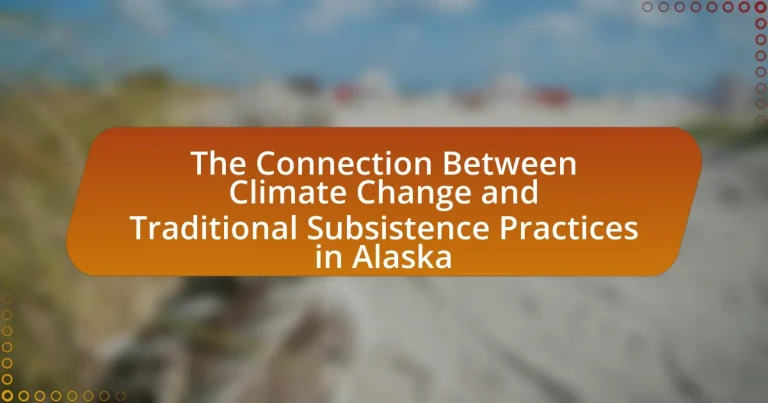The article examines the significant connection between climate change and traditional subsistence practices in Alaska, highlighting how rising temperatures and shifting ecosystems impact Indigenous communities’ food sources and cultural identity. It details the specific climate changes occurring in Alaska, such as increased temperatures, melting glaciers, and altered wildlife patterns, which threaten the sustainability of subsistence hunting, fishing, and gathering. The article also discusses the adaptations made by local communities in response to these environmental changes, the implications for food security and cultural heritage, and the role of policy and governance in supporting traditional practices amidst climate challenges. Additionally, it outlines current initiatives aimed at assisting Alaskan communities and emphasizes the importance of integrating traditional ecological knowledge with modern resource management strategies.

What is the connection between climate change and traditional subsistence practices in Alaska?
Climate change significantly impacts traditional subsistence practices in Alaska by altering ecosystems and wildlife patterns essential for Indigenous communities. As temperatures rise and precipitation patterns shift, species such as fish and game animals experience changes in migration, breeding, and availability, directly affecting food sources for subsistence hunters and gatherers. For instance, the decline in sea ice due to warming temperatures disrupts hunting practices for marine mammals, which are crucial for nutrition and cultural identity. Additionally, changing plant growth cycles affect the availability of traditional food sources like berries and roots. These shifts threaten the sustainability of subsistence lifestyles that have been practiced for thousands of years, highlighting the urgent need for adaptive strategies in response to climate change.
How does climate change impact the environment in Alaska?
Climate change significantly impacts the environment in Alaska by causing increased temperatures, melting glaciers, and altering ecosystems. Average temperatures in Alaska have risen by approximately 3°F (1.6°C) since the 1970s, leading to the rapid melting of glaciers, which affects freshwater availability and sea levels. Additionally, changing temperatures disrupt wildlife habitats, resulting in shifts in species distribution and affecting traditional subsistence practices such as hunting and fishing. For instance, the decline of sea ice impacts marine species like seals and polar bears, which are crucial for the subsistence lifestyle of Indigenous communities. These environmental changes threaten food security and cultural practices tied to the land and sea.
What specific climate changes are occurring in Alaska?
Alaska is experiencing significant climate changes, including rising temperatures, increased precipitation, and melting glaciers. Average temperatures in Alaska have risen by approximately 3°F (1.6°C) since the late 20th century, with projections indicating further increases. Additionally, precipitation has increased by about 15% over the past 50 years, leading to altered ecosystems and wildlife patterns. Glaciers in Alaska are retreating at an alarming rate, with studies showing that they are losing mass at a rate of about 75 billion tons per year. These changes impact traditional subsistence practices, as they affect the availability of resources such as fish and game, which are vital for local communities.
How do these changes affect local ecosystems?
Climate change significantly disrupts local ecosystems in Alaska by altering species distributions, affecting food webs, and changing habitat conditions. For instance, rising temperatures lead to the northward migration of species such as fish and marine mammals, which can upset existing predator-prey relationships. Additionally, melting permafrost impacts soil stability and water availability, further stressing plant and animal communities. Research indicates that these ecological shifts can threaten the traditional subsistence practices of Indigenous peoples, as their reliance on specific species for food and cultural practices becomes increasingly precarious.
What are traditional subsistence practices in Alaska?
Traditional subsistence practices in Alaska include hunting, fishing, and gathering, which are essential for the survival and cultural identity of Indigenous communities. These practices involve the seasonal harvesting of resources such as salmon, caribou, and berries, reflecting a deep understanding of local ecosystems. For instance, the Alaska Department of Fish and Game reports that subsistence fishing provides over 50% of the fish consumed by rural Alaskan households, highlighting its significance. Additionally, these practices are governed by traditional ecological knowledge, which has been passed down through generations, ensuring sustainable use of resources in the face of environmental changes.
What types of subsistence practices are commonly used by Alaskan communities?
Alaskan communities commonly use hunting, fishing, and gathering as subsistence practices. These practices are integral to their cultural identity and survival, providing food and materials necessary for daily life. Hunting includes the pursuit of marine mammals like seals and whales, as well as land animals such as caribou and moose. Fishing is vital, with salmon being a primary target, especially during spawning seasons. Gathering involves collecting wild plants, berries, and roots, which supplement their diet. These subsistence methods are deeply rooted in traditional knowledge and are adapted to the local environment, reflecting the communities’ reliance on natural resources for sustenance.
How have these practices evolved over time?
Traditional subsistence practices in Alaska have evolved significantly over time due to climate change impacts. Historically, Indigenous communities relied on seasonal patterns for hunting, fishing, and gathering, which were closely aligned with stable environmental conditions. However, as climate change has altered these patterns—such as shifting animal migration routes and changing fish populations—communities have adapted by modifying their practices. For instance, the introduction of new technologies, like GPS for navigation and modern fishing gear, has allowed for more efficient harvesting. Additionally, knowledge sharing among generations has become crucial as elders pass down traditional ecological knowledge to navigate these changes. Studies, such as those by the Alaska Native Science Commission, highlight that these adaptations are essential for maintaining food security and cultural identity in the face of ongoing environmental shifts.
Why is the connection between climate change and subsistence practices significant?
The connection between climate change and subsistence practices is significant because it directly impacts the livelihoods and food security of communities that rely on traditional methods for survival. In Alaska, for instance, rising temperatures and changing weather patterns disrupt the availability of wildlife and fish, which are crucial for subsistence hunting and fishing. Research indicates that 80% of Alaska Native communities depend on subsistence resources, and climate change threatens these resources by altering migration patterns and habitat conditions. This disruption not only affects food availability but also undermines cultural practices and traditional knowledge associated with subsistence activities, highlighting the critical need for adaptive strategies to sustain these practices in the face of climate change.
What are the implications for food security in Alaskan communities?
Food security in Alaskan communities is significantly threatened by climate change, which disrupts traditional subsistence practices. As temperatures rise and weather patterns shift, the availability of key resources such as fish and game diminishes, impacting local diets and economies. For instance, studies indicate that changing ice conditions affect hunting and fishing schedules, leading to reduced harvests. Additionally, the loss of sea ice and altered migration patterns of wildlife further exacerbate food scarcity, making it challenging for communities to maintain their cultural practices and nutritional needs.
How does this connection affect cultural identity and heritage?
The connection between climate change and traditional subsistence practices in Alaska significantly impacts cultural identity and heritage by threatening the very practices that define Indigenous ways of life. As climate change alters ecosystems, traditional hunting, fishing, and gathering practices become increasingly difficult, leading to a loss of cultural knowledge and practices passed down through generations. For instance, the decline in sea ice affects the hunting of marine mammals, which are central to the cultural identity of many Indigenous groups in Alaska. This disruption not only affects food security but also diminishes the transmission of cultural values and traditions associated with these subsistence activities, as highlighted in the report by the Alaska Native Tribal Health Consortium, which emphasizes the importance of these practices for maintaining cultural heritage.
How do Alaskan communities adapt to climate change in their subsistence practices?
Alaskan communities adapt to climate change in their subsistence practices by altering hunting, fishing, and gathering schedules to align with changing animal migration patterns and seasonal cycles. For instance, as ice melts earlier in the spring, communities adjust their hunting times for marine mammals like seals and whales to ensure successful harvests. Additionally, they are increasingly relying on traditional ecological knowledge to identify new food sources and adapt to shifts in fish populations, such as the movement of salmon to cooler waters. Research indicates that these adaptations are crucial for maintaining food security and cultural practices, as highlighted in the report by the Alaska Native Tribal Health Consortium, which emphasizes the importance of community resilience in the face of environmental changes.
What strategies are being implemented to cope with changing environmental conditions?
Communities in Alaska are implementing various strategies to cope with changing environmental conditions, including adaptive management of natural resources, traditional ecological knowledge integration, and community-based monitoring systems. Adaptive management involves adjusting hunting and fishing practices based on observed changes in wildlife populations and migration patterns, which are increasingly affected by climate change. For instance, the Alaska Native Science Commission emphasizes the importance of traditional ecological knowledge, which incorporates local observations and practices that have been passed down through generations, allowing communities to respond effectively to environmental shifts. Additionally, community-based monitoring systems enable local residents to collect data on environmental changes, fostering resilience and informed decision-making. These strategies are essential for sustaining traditional subsistence practices in the face of climate change impacts.
How do traditional knowledge and practices contribute to adaptation efforts?
Traditional knowledge and practices significantly enhance adaptation efforts by providing insights into sustainable resource management and resilience strategies. Indigenous communities in Alaska, for instance, utilize centuries-old practices that are finely tuned to local environmental conditions, enabling them to adapt to climate variability. Research indicates that these practices, such as seasonal migration patterns and traditional hunting techniques, are informed by a deep understanding of ecological changes, which helps communities respond effectively to shifting climate conditions. The integration of traditional ecological knowledge with scientific approaches has been shown to improve adaptive capacity, as evidenced by studies highlighting successful community-led initiatives that blend local wisdom with modern conservation strategies.
What are the long-term consequences of climate change on traditional subsistence practices in Alaska?
Climate change has significant long-term consequences on traditional subsistence practices in Alaska, primarily through altered ecosystems and resource availability. As temperatures rise, the melting of sea ice and permafrost disrupts the habitats of key species such as fish, marine mammals, and terrestrial wildlife, which are essential for the subsistence lifestyle of Indigenous communities. For instance, the decline in sea ice affects hunting patterns for species like seals and polar bears, while changes in water temperature impact fish populations, leading to reduced catches for local fishermen. Additionally, shifting vegetation patterns due to climate change can affect the availability of traditional food sources like berries and roots. These changes threaten food security, cultural practices, and the transmission of traditional knowledge, as younger generations may struggle to engage in subsistence activities that are becoming increasingly difficult due to environmental changes.
How might future climate scenarios impact these practices?
Future climate scenarios may significantly disrupt traditional subsistence practices in Alaska by altering ecosystems and wildlife patterns. As temperatures rise and precipitation patterns shift, species such as fish and game may migrate or decline, impacting food availability for Indigenous communities reliant on these resources. For instance, studies indicate that warmer waters affect salmon spawning, which is crucial for local diets and economies. Additionally, melting sea ice alters hunting routes and access to marine mammals, further threatening food security. These changes underscore the vulnerability of subsistence practices to climate variability, necessitating adaptive strategies to sustain cultural and nutritional needs.
What role do policy and governance play in supporting subsistence practices amidst climate change?
Policy and governance play a critical role in supporting subsistence practices amidst climate change by establishing frameworks that protect traditional rights and resources. Effective policies can ensure access to land and water, which are essential for subsistence activities like hunting and fishing, particularly as climate change alters ecosystems. For instance, the Alaska Native Claims Settlement Act of 1971 recognized the land rights of Alaska Natives, enabling them to maintain their subsistence lifestyles despite environmental changes. Additionally, governance structures that involve local communities in decision-making processes can enhance resilience by integrating traditional ecological knowledge with scientific research, thereby fostering adaptive strategies to cope with climate impacts.
What can be done to support traditional subsistence practices in the face of climate change?
To support traditional subsistence practices in the face of climate change, it is essential to implement adaptive management strategies that incorporate indigenous knowledge and practices. These strategies can include the establishment of community-led resource management programs that prioritize the sustainable use of local ecosystems, ensuring that traditional practices are preserved and adapted to changing environmental conditions.
Research indicates that integrating traditional ecological knowledge with scientific approaches can enhance resilience against climate impacts. For example, a study by the Alaska Native Science Commission highlights how local communities can monitor changes in wildlife patterns and adjust their subsistence activities accordingly, thereby maintaining food security and cultural practices.
Additionally, policy frameworks should be developed to protect traditional lands and resources from industrial encroachment, which can exacerbate the effects of climate change. By fostering collaboration between indigenous communities, government agencies, and environmental organizations, traditional subsistence practices can be effectively supported and sustained in the face of ongoing climate challenges.
What initiatives are currently in place to assist Alaskan communities?
Currently, initiatives to assist Alaskan communities include the Alaska Native Tribal Health Consortium’s programs aimed at improving health outcomes and resilience against climate change impacts. These programs focus on enhancing food security through traditional subsistence practices, which are increasingly threatened by environmental changes. For example, the consortium has implemented community-based projects that promote the sustainable harvesting of local resources, ensuring that traditional practices can continue despite shifting climate conditions.
How can individuals and organizations contribute to preserving these practices?
Individuals and organizations can contribute to preserving traditional subsistence practices in Alaska by actively engaging in advocacy, education, and sustainable resource management. Advocacy efforts can include supporting policies that protect indigenous rights and traditional lands, which are crucial for maintaining these practices. Education initiatives can focus on raising awareness about the cultural significance of subsistence practices and the impacts of climate change on these traditions. Furthermore, organizations can collaborate with local communities to implement sustainable practices that ensure the availability of natural resources, such as fish and game, which are vital for subsistence. For example, the Alaska Native Science Commission emphasizes the importance of integrating traditional ecological knowledge with modern science to enhance resource management strategies.


